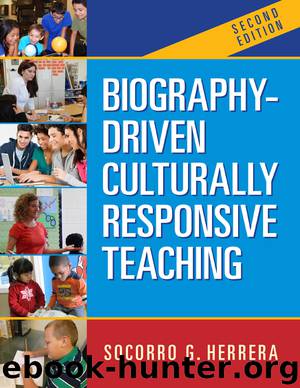Biography-Driven Culturally Responsive Teaching by Socorro G. Herrera

Author:Socorro G. Herrera
Language: eng
Format: epub
Publisher: Teachers College Press
Published: 2016-02-22T16:00:00+00:00
In differentiated instruction, educators strive to make adaptations to their teaching to meet the needs of the particular individuals in the classroom. What this looks like during vocabulary instruction often tends to be a shade of gray, because teachers frequently continue to use the same worksheet or technique to teach vocabulary to all students, regardless of biography.
When selecting target vocabulary, consideration of the type of vocabulary words being identified directly affects CLD students. Vocabulary words that are merely new labels for concepts that CLD students already understand are approached differently than words that represent new and potentially difficult concepts (Garcia, 2003). Ultimately, the question becomes “When my CLD students finish this lesson, will they be able to tell me the essence of the story or concept I have been teaching, given the words I have selected as the target vocabulary?” Often, teachers will comment that there are too many words to teach. What is important to remember is that some words are taught through “incidental” opportunities, whereas others must be taught “intentionally.” Understanding this distinction relieves undue pressure while still ensuring that words needed for content tests and high-stakes tests are made accessible to all students.
Critical to this entire process of selecting and teaching vocabulary words is knowing the biographies of all of our students! More specifically, it is essential that we teachers delve into our CLD students’ funds of knowledge, prior knowledge, and academic knowledge. Knowing which concepts the student possesses in his or her native language will help us determine the type of instruction needed to teach key words. For example, if a student has already studied fotosíntesis (photosynthesis) in his or her native country, then a simple translation of the English term into Spanish may be all that is necessary to clarify the concept.
When educating CLD students, vocabulary instruction must be approached from the perspective that, although a student may not be proficient in English, he or she is surrounded by English words, words in the native language, and lived experiences that may support the teaching of the academic words. Consider the following scenario:
Saul, a middle school student, had been referred for testing given his slow academic progress. As is customary when I am invited to assess an ELL learner using multiple district assessments in Spanish, I began by getting to know the student prior to formally beginning the testing. That day I asked Saul to share a little about the school and his teachers. I was amazed at how articulate he was regarding his perception about what was right and what was lacking in his education.
First, he told me that not all teachers wanted him to learn. That is, some of his teachers, although they did not speak Spanish, went to great lengths to teach him the academic content so he could be a good student. Some, he said, were not as eager, and he thought they saw him as a slow learner, given his background. Since Saul had not mentioned his ESL teacher, I asked, “What about your ESL teacher?” He responded, “Oh! Her….
Download
This site does not store any files on its server. We only index and link to content provided by other sites. Please contact the content providers to delete copyright contents if any and email us, we'll remove relevant links or contents immediately.
The Art of Coaching Workbook by Elena Aguilar(51000)
Trainspotting by Irvine Welsh(21521)
Twilight of the Idols With the Antichrist and Ecce Homo by Friedrich Nietzsche(18510)
Fangirl by Rainbow Rowell(9104)
Periodization Training for Sports by Tudor Bompa(8173)
Change Your Questions, Change Your Life by Marilee Adams(7638)
This Is How You Lose Her by Junot Diaz(6800)
Asking the Right Questions: A Guide to Critical Thinking by M. Neil Browne & Stuart M. Keeley(5653)
Grit by Angela Duckworth(5525)
Red Sparrow by Jason Matthews(5392)
Paper Towns by Green John(5092)
Room 212 by Kate Stewart(5041)
Ken Follett - World without end by Ken Follett(4647)
Housekeeping by Marilynne Robinson(4349)
The Sports Rules Book by Human Kinetics(4299)
Double Down (Diary of a Wimpy Kid Book 11) by Jeff Kinney(4209)
Papillon (English) by Henri Charrière(4199)
The Motorcycle Diaries by Ernesto Che Guevara(4018)
Exercise Technique Manual for Resistance Training by National Strength & Conditioning Association(3960)
